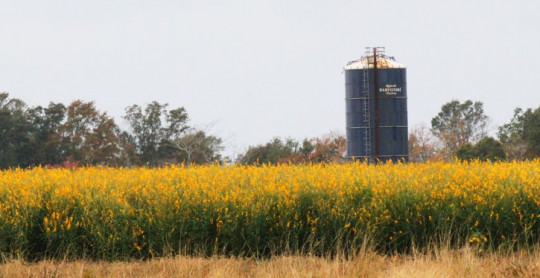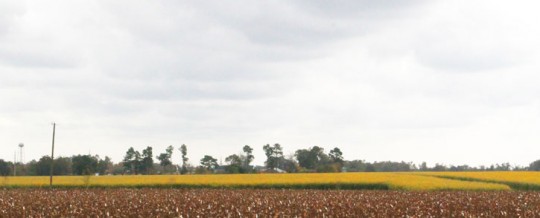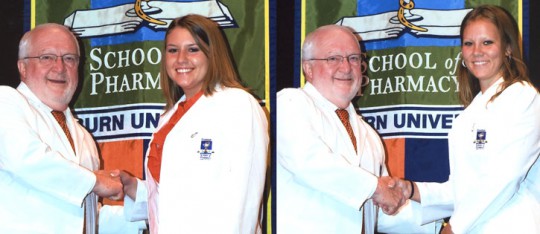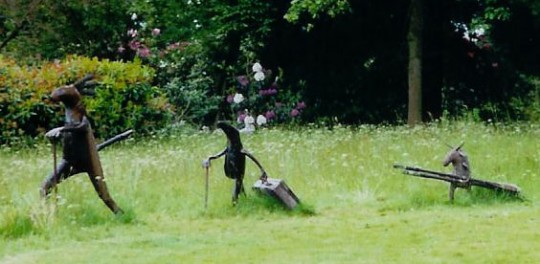Flomaton Cheerleader Performs In Disney Parade
November 30, 2011
Ronna Tullis from Flomaton High School was one of more than 500 student cheerleaders and dancers from across the country to perform in the Thanksgiving Day Parade last week at Walt Disney World in Orlando.
The individuals invited to perform in the parade were part of a select group of cheerleaders chosen as cheerleading and dance All Americans during Universal Cheerleaders Association and Universal Dance Association summer camps across the country.
Pictured top: Ronna Tullis from Flomaton High School performed in the Thanksgiving Day Parade last week at Walt Disney World in Orlando. Submitted photo for NorthEscambia.com, click to enlarge.
What’s That Mystery Molino Crop With The Yellow Flowers?
November 30, 2011
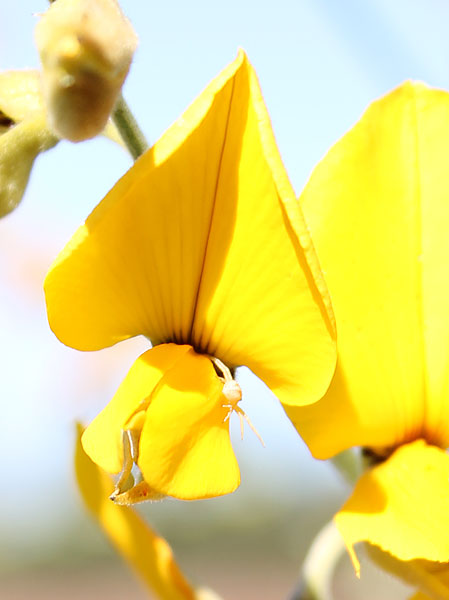 We received a lot of emails over the past few weeks asking about the unique yellow-flowering crop planted at Highway 29 and Highway 97 behind the Tom Thumb in Molino.
We received a lot of emails over the past few weeks asking about the unique yellow-flowering crop planted at Highway 29 and Highway 97 behind the Tom Thumb in Molino.
NorthEscambia.com turned to Libbie Johnson of Escambia County Extension and to the farmer, Eric Koehn of Walnut Hill, to find out that the plant is called Sunn Hemp (that’s Crotalaria juncea L for the scientific types).
For a photo gallery, click here.
It is a semi-tropical plant that is grown as a cover crop in the southeast. It’s a legume, growing in a variety of locations and returning nitrogen to the soil. It can also be used as a biomass to produce biofuels.
“Because it grows so fast, it is really good for people looking to get something on their soil to prevent erosion or to build organic matter into their soils,” Johnson said. “It is touted as being resistant to root knot nematodes- a real problem for our local row crop producers, so it would be good to use in a rotation. It takes about 8-12 weeks of growth for you to get the full benefit of the crop, so it’s best if it’s planted after corn or maybe a vegetable crop. It wouldn’t have time to get going if planted after cotton or peanuts.”
Koehn said he planted the Sunn Hemp as cover crop to prevent erosion after he harvested corn from the field. There were no plans to harvest the crop.
Pictured: Recent photos showing Sunn Hemp growing at Highway 29 and Highway 97 in Molino. NorthEscambia.com photos, click to enlarge.
Local Students Recognized As Rotary Four-Way Test Essay Winners
November 30, 2011
Four Escambia County students — including one each from Northview and West Florida high schools — were recognized as winners in the 19th annual Rotary Four-Way Test Essay Contest by the Suburban West Rotary Club.
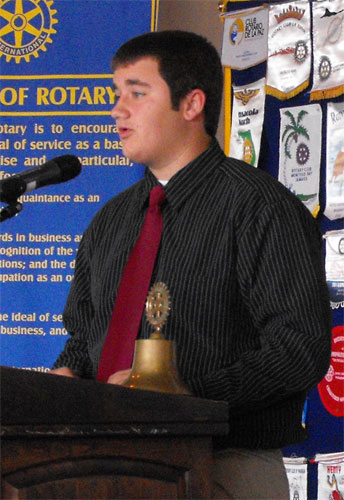 Winners included Justin Halteman (pictured) from Northview High School, Rachel George from West Florida High School and Jennifer Lewis from Escambia High School. Grand prize winner was Destiny Williams from Booker T. Washington High School.
Winners included Justin Halteman (pictured) from Northview High School, Rachel George from West Florida High School and Jennifer Lewis from Escambia High School. Grand prize winner was Destiny Williams from Booker T. Washington High School.
The Four-Way Test Essay Contest is open to all Escambia County sophomores and juniors, with each participant writing a short essay on the topic “Why is the Rotary Four-Way Test relevant today?”. The Four-Way Test is used by Rotarians to encourage value-driven, ethical behavior at work, at home and in the community.
During a recent luncheon, the winners read their essays to the club and were presented with certificates of achievement and cash prizes. The contest finalist from each participating high school received a $100 award, and the grand prize winner received a $500 award.
Pictured: Justin Halteman of Northview High School reads his award winning essay to the Suburban West Rotary Club. Submitted photo for NorthEscambia.com, click to enlarge.
Bratt Student’s Art Tops Among 1,020 Contest Entries
November 29, 2011
 A Bratt Elementary School fifth grader Ashtyn Carnley’s artwork was chosen as one of the best over over 1,000 entries in a recent “Express Yourself” art contest held in conjunction with the Pensacola Symphony Orchestra.
A Bratt Elementary School fifth grader Ashtyn Carnley’s artwork was chosen as one of the best over over 1,000 entries in a recent “Express Yourself” art contest held in conjunction with the Pensacola Symphony Orchestra.
Bratt’s fifth grade students recently went on a field trip to hear the orchestra perform. During an art class prior to the field trip, the students listened to music while creating art work inspired by the piece titled “Pirates of the Caribbean.”
About 1,020 students in Escambia and Santa Rosa counties created music-inspired artwork for the competition. Three top winners were chosen from each county.
Second place was awarded to Carnley of Bratt Elementary for her artwork titled “Battle of the Atlantic”. She will be receiving a $250 savings bond from Regions Bank.
Pictured top: Ashtyn Carnley with her award-winning artwork “Battle of the Atlantic”. Pictured below: Bratt Elementary art teacher Meredith Roberts, Ashtyn Carnley and Bratt music teacher Emily Pollard. Submitted photos for NorthEscambia.com, click to enlarge.
Weekend In Photos
November 28, 2011
If you missed NorthEscambia.com over the weekend, you missed over 200 photos from several events. Click an item below to view the corresponding story and/or photo gallery.
Two North Escambia Residents Inducted Into Auburn Harrison School Of Pharmacy
November 27, 2011
Two North Escambia residents are part of the latest class at the Auburn University Harrison School of Pharmacy.
Meridith Lynn Weaver of Molino and Nicole Marie Haubrich of Cantonment were among 148 students entering the Doctor of Pharmacy program. They were inducted into the program during a White Coat Ceremony — a rite of passage for first-year pharmacy students as they don their white coats and make an oath affirming their commitment to the highest standards of ethics and patient care.
Meridith Weaver is the daughter of Archie and Cheryl Weaver of Molino. Nicole Haubrich is the daughter of Nicholas and Ellen Haubrich.
Pictured: Dr. R. Lee Evens, dean of the Auburn University Harrison School of Pharmacy, welcomes Meridith Weaver (left) and Nicole Haubrich (right). Submitted photos for NorthEscambia.com, click to enlarge.
Photos: Crowds Attend Pow Wow
November 27, 2011
Large crowds attended the 41st annual Pow Wow over the long Thanksgiving weekend at the Poarch Creek Indian Reservation north of Atmore. The event featured tribal dancers from across the country, entertainment, food, arts and crafts and several historical and cultural presentations.
For more photos from the event, click here.
Pictured: The 41st annual Pow Wow on the Poarch Creek Indian Reservation north of Atmore. NorthEscambia.com photos by Marcella Wilson, click to enlarge.
Featured Recipe: Orange Morning Kisses
November 27, 2011
Today’s featured recipe is “Morning Kisses” — orange-scented breakfast treats that are much like a traditional beignet.
Creative Gardening Gift Ideas
November 26, 2011
 Still don’t have a Christmas present for your favorite gardener? Take heart, there is still plenty of time to find, or make, that perfect “green” gift.
Still don’t have a Christmas present for your favorite gardener? Take heart, there is still plenty of time to find, or make, that perfect “green” gift.
Many gardeners don’t think of their landscapes as just plants in the ground. To the knowledgeable landscape designer, the landscape is a series of rooms; rooms that may require decoration.
Garden art can be anything from the whimsical garden gnomes, functional obelisks or metal sculptures.
Garden obelisks can serve many functions. In addition to providing interest during all four seasons, they can act as beautiful focal points in the garden. They can make your garden look as if it was designed by a professional.
In a flower garden, they provide support for plants such as climbing roses, flowering vines and many other climbers and twiners. In the edible garden, many types of fruits and vegetables, such as various types of beans, can be grown on obelisks.
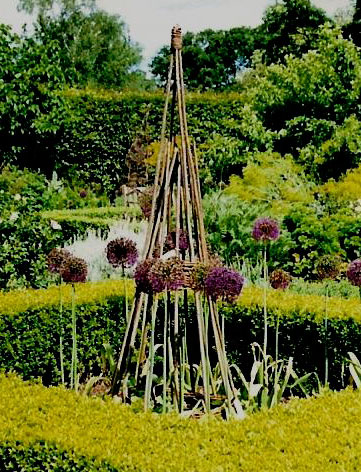 Obelisks come in many different sizes and shapes. Common shapes include tall, rounded or oblong forms, rectangular forms, and pyramids. Most vining plants will take to any shape. Choose the shape that is pleasing to you and blends in with your garden design. Obelisks can be made from a variety of materials including cedar, copper and wrought iron.
Obelisks come in many different sizes and shapes. Common shapes include tall, rounded or oblong forms, rectangular forms, and pyramids. Most vining plants will take to any shape. Choose the shape that is pleasing to you and blends in with your garden design. Obelisks can be made from a variety of materials including cedar, copper and wrought iron.
Furthermore, if you are an avid recycler, there are plenty of materials just laying around that can be made into a functional obelisk with a minimum amount of skill and time. Take a look on the internet and you will find plenty of help in fashioning a home-made creation.
A “growing” trend is metal garden art. Metal garden art can be fun, playful or even classical. It can be used to create a focal point in the garden or to brighten up a dull spot. From small garden stakes, to colorful wall art, to sculptures small and large, the possibilities are endless. With so many materials to choose from and so many artists working in the field you will be sure to find at least one piece to add color and character to your yard.
Again, if you are an avid recycler, you will be able to find many pieces made from recycled metal. Recycled steel drums or tanks, discarded bicycle or tricycles, old car parts, these all provide the raw materials for the creative eco-artist.
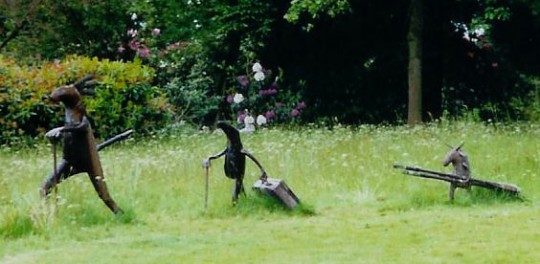 Copper is widely used in metal garden art because it is beautiful, durable and adds elegance to any garden. If allowed to oxidize it will age gracefully to a natural weather worn green patina. It can also be preserved with a clear coating to maintain its bright, shiny look. Copper sculptures, wall art and garden stakes add a touch of class to any decor.
Copper is widely used in metal garden art because it is beautiful, durable and adds elegance to any garden. If allowed to oxidize it will age gracefully to a natural weather worn green patina. It can also be preserved with a clear coating to maintain its bright, shiny look. Copper sculptures, wall art and garden stakes add a touch of class to any decor.
For a classic look add a bronze garden sculpture. Bronze sculptures have been around for thousands of years. They remain popular today because they are classic, timeless and will last for generations.
Whatever your taste, classic, contemporary or just playful, garden art will warm your heart even on the coldest winter day.
Theresa Friday is the Residential Horticulture Extension Agent for Santa Rosa County.
Submitted photos for NorthEscambia.com, click to enlarge.
Photo Gallery: Northview Cheerleaders, Band And Dance Team
November 26, 2011
The Northview Chiefs defeated Freeport Friday night for a regional championship.
- For a photo gallery with the cheerleaders, click here.
- For a photo gallery with the band and dance team, click here.
- For a photo gallery with action from the game, click here.
For a game summary, click here.
NorthEscambia.com photos, click to enlarge.



